|
1.
CENTRAL/ WEST AFRICA
Log prices edge up as markets stabilize
Log prices at the end of March reflected brisk trading conditions and generally stable markets with an ongoing price rising trend for species in strong demand. The log trading business continued to be driven by high demand from China, India and, to a lesser degree, Japan, with Europe continuing the long-term reduction in volume and number of traded species and emphasis on lumber and timber product imports. Sapelli log prices showed modest
gains of euro7-8 per m3 for LM and B grades, and euro15 per m3 for BC/C grade for European destinations but no change in prices for Asian buyers.
The competition for padouk drove prices noticeably higher, with LM and B grades up by euro46-61 per m3,although BC/C grade for Europe declined marginally.Okan prices for Asia gained ground again, adding another euro15 per m3 for LM and B grades, while prices for Europe remained unchanged. Prices for other species also moved higher for Asian destinations, but were unchanged for Europe. Tali climb ed between euro30 and euro45 per m3 while movingui rose by euro7 per m3 for Asia. Although European demand for movingui was low, prices moved up by euro15 to match prices for Asia. West African exporters have now rather quickly begun to see price gains in tandem with the recent steady uptrend for Southeast Asian log prices.
Sawnwood prices leap amid improved demand
Sawn lumber traders and exporters were also pushing prices higher. The market sentiment was due in part to the strong performance and rising prices for competing Asian species and better demand from European buyers closing business for the spring and summer stocks. The sudden
improvement in weather across Europe was helping to stimulate construction. Padouk was in very strong demand with FAS GMS prices moving up by euro42 to euro520 per m3 while fixed sizes and scantlings rose euro12 to euro500 per m3.
Special sizes of iroko in strips for Asian buyers fetched $500 per m3 while special squares at $600 per m3 were at premium over the GMS grade for Europe which stabilised at euro458 per m3. Once again, sapelli lumber did not enjoy the increase seen in log prices, probably due to high level of production and keen competition. Okoume fixed sizes were at $275 per m3 for Asian destinations.
Freight for sawn lu mber roll on/roll off to Europe dropped slightly from euro62 to euro59.50 per m3 while other routes were
unchanged.
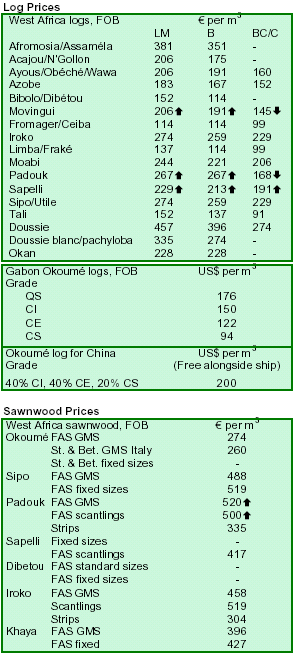
2. GHANA
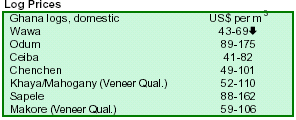
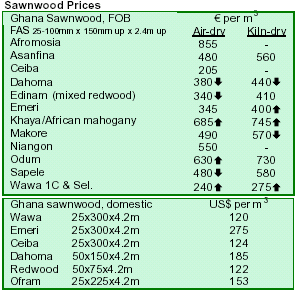
3.
MALAYSIA
Southeast Asian plywood availability shrinks
As many Indonesian plywood mills stopped production activities due to insufficient log supplies, remaining manufacturers have order backlogs of several months from Europe. Euwid reported that European buyers have turned to Malaysia but the Malaysian plywood industry
has been unable to cover the extra demand from Europe at short notice. Malaysian plywood mills are reported to be producing almost at top capacity. The serious shortage in Southeast Asian plywood is likely to result in further price rises. Some producers can not even guarantee a
fixed delivery date in spite of the high prices. Some buyers have expressed doubts about the quality of Malaysia plywood whose average is said to be below that of the Indonesian material.
Eco-friendly roofing insulators for Europe
Italian company Kenaf Eco Fiber Italy Spa (Kefi) and its Malaysian partner are investing 40 million ringgit ($10.8 million) to set up a factory in the state of Terengganu to make ecologically -friendly building insulators and
particleboards. Kefi owns 30% of Kenaf Eco Fibre (M) Sdn Bhd (Kefima). Kefi expects to benefit from Malaysia¡¯s tropical weather by harvesting 30 tons per hectare, doubling the productivity in Italy. Currently,about 1,000 ha are planted with kenaf in Setiu and there is potential to expand planting to 5,000 ha.
Kefi indicates an increasing demand for eco-friendly roofing insulators in Europe. Beginning 1 October 2006,Italy will make it mandatory for house-builders to replace fibre -glass and asbestos with eco-friendly materials like kenaf.
New training centre for furniture technology
Plantation Industries and Co mmodities Deputy Minister Datuk Anifah Aman launched a Machinery Technology and Furniture Manufacturing Course at the Wood Industry Skills Development Centre (Wisdec) at Kota Kinabalu Industrial Park (KKIP) in Sabah.
Mr. Anifah said Sabah accounted for less than 2% of Malaysia¡¯s 7.67 billion ringgit wooden and rattan furniture exports in 2005. The continuous demand for Malaysia¡¯s furniture products from countries such as the USA, Japan and other Asian countries, had helped Sabah¡¯s furniture industry to secure a small slice of the market. He said the Government was hoping that Sabah would be able to export furniture worth 10 billion ringgit
by 2010.
Mr. Anifah said the Federal Government had spent
millions of ringgit to set up training centres such as Wis dec that specifically caters for the
development of skills in the wood industry. The Government had also set aside allocations to purchase state-of-the-art machinery to enable Sabah Wisdec to play its role as a premier
training institution. Mr. Anifah added the Sabah Wisdec would be the largest wood industry training centre in Southeast Asia.
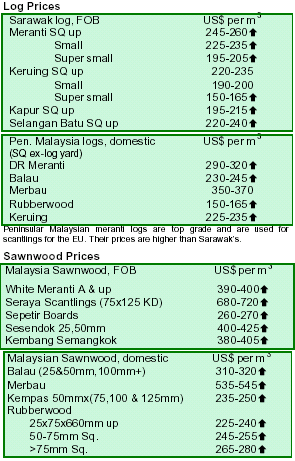
4.
INDONESIA
RAPP obtains first LEI plantation certificate
Singapore¡¯s Asia Pacific Resources International Ltd (APRIL) has informed that its subsidiary Riau Andalan Pulp and Paper (RAPP) has successfully attained certification from the Indonesian Ecolabelling Institute (Lembaga Ekolabel Indonesia, LEI), for its fibre plantation operations in Riau, Indonesia, the first
certified plantation forest in the country. The certification followed two phases of field assessments conducted by LEI-accredited assessors in November 2004 and September 2005 and an investment of $31,000 by RAPP.The final assessment report was approved on 24 January
2006 by the LEI Expert Panel.
According to RAPP president, Irsan Syarief, the
company, which commenced operations in 1995, obtains up to 60% of its raw materials from its timber plantations and expects to source all its raw materials from the plantations by 2010. He added that the firm has replanted more than 115,000 hectares with timber plantations since
2004. The company manages 254,000 hectares of forests,including 150,000 hectares of timber plantations. RAPP is part of the Indonesian Raja Garuda Mas Group.
APRIL, which operates in Indonesia and China, is a leading producer of fibre, pulp and paper. It operates one of the world¡¯s largest pulp mills with an annual production capacity of two million tonnes in Indonesia.The company has also obtained ISO 14001 certification for environmental management and OHSAS 18001 for health and safety.
Recurring Riau fires raise concerns in Malaysia
The Ministry of Natural Resources and Environment of Malaysia has expressed concern over haze coming from forest fires in the Indonesian province of Riau, the head of Riau environmental impact management agency,Khairul Zainal, said recently. Mr. Zainal dispatched a 45-member quick reaction team (TRC) tasked with monitoring the Bukit Batu reserved forests in Bengkalis district and putting out hot spots.
Malaysia has offered to cooperate in putting out hot spots in Riau islands and in exchanging information on how to handle forest fires which have become a recurrent problem in Indonesia. Besides polluting the air and endangering wildlife, the annual forest fires disrupt
flights in neighbouring countries like Singapore and Malaysia. Mr. Zainal added that in some areas in Riau such as the Senepis wildlife reserve near the town of Dumai and a forest area in Rupat Utara subdistrict in the Bengkalis district were on fire. The two areas are close to the Malaysian state of Malacca. Data from the Bengkalis
district administration showed 75 hot spots in Bengkalis and Rokan Hilir districts and in Dumai.
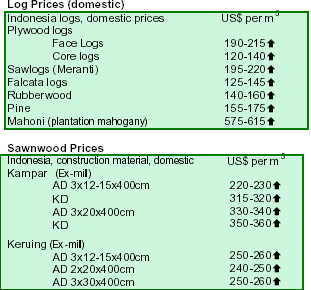
5.
MYANMAR
Conditions hold firm for hardwood market
Market conditions remained largely unchanged for teak and other hardwoods. Demand for teak logs remained fairly strong despite the two February price hikes.Pyinkado market remained fairly active and resilient to price increases. Gurjan market continued its sluggishness, with fresh logs being sold easily at current prices. However, gurjan logs from previous harvest
seasons were still left unsold in Yangon log depots.
Border trade with Thailand grows
In addition to Century Dragon, a Myanmar timber trade company (see TTM 11/1), two more
Myanmar companies, Asia World and Woodland Co., have been authorized to trade timber from the border to Thailand by land route. The checkpoint is at the Tachileik-Maesai area on the
Myanmar-Thai border.
Myanmar raises officials¡¯ salaries by up to 1,200%
Myanmar will raise the salaries of its civil servants and arm forces by between 500 and 1,200%, a move analysts warn could worsen inflation and add to pressure on the country¡¯s currency. Economic analysts acknowledge that
current salaries are too low but expressed concern that the sheer magnitude of the sudden wage rises will trigger an immediate rise in the prices of basic commodities,currently under pressure by the elimination of fuel subsidies in October 2005.
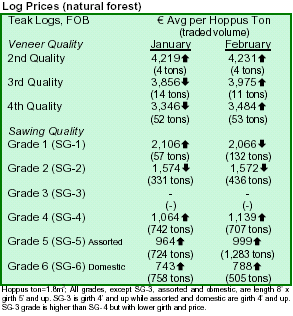
6. PAPUA
NEW GUINEA
Surge in PNG log exports in February
Log exports from PNG amounted to 187,543 m3 in January and surged to 284,137 m3 in February 2006. Saw/veneer grades accounted for 85% of the log exports. Main log export species were malas, taun, bintangor and terminalia. China took 78% of all log exports, followed by Japan (8.5%), Vietnam (6%) and Korea (4%). Of the saw/veneer log grades, China imported 87%, Japan 6.3%,
Korea 2.7% and Vietnam 1.3%. For plantation species,kamarere remained the main export species primarily to the markets of Vietnam, Japan, China and Korea.
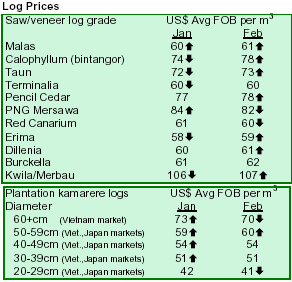
7.
BRAZIL
Strong real drives domestic prices up
Prices of wood products in Brazilian real (BR) remained stable in March but surged 2.3% in US dollars due to a further weakening of the US currency. The BR has strengthened 30% since mid-2004 and over 7% in the first quarter of this year against the US dollar (see currencies graph, p. 16).
Marginal growth in 2005 timber exports
Brazilian exports of solid wood products reached $3.03 billion in 2005, up 0.4% from 2004.Tropical plywood exports rose 14% to 1.14 million m3 (up 13% to $421.3 million) in 2005. Pine plywood exports creeped 2.4% to 1.89 million m3 (but down 2% to $510.1 million) in 2005. Exports of pine lumb er fell 3.8% to 1.56 million m3 (but up 3.2% to $303.9 million) in 2005. Exports of tropical lumber declined 7.4% to 1.75 million m3 (up
6.4% to $578.3 million). Furniture exports increased 4.7% to $871.6 million in 2005.
Early 2006 sees tropical timber exports plunging
Exports of solid wood products declined to $265.4 million in January 2006, down 3.6% from the same
month last year. The decline was due to shortfalls in exports for tropical plywood (-49.7%), wooden furniture (-14.6%) and tropical lumber (- 6.2%), in spite of increases for pine lumber (+28.4%) and pine plywood (+10.8%).
Exports of solid wood products declined 5.2% to $295.1 in February 2006 as compared with the same month in 2005. The decline was due to contraction in tropical plywood (-40%), tropical lumber (-19%) and wooden furniture (-10.7%) despite expansion in pine lumber (+30.5%) and pine plywood (+3.5%).
Brazilian elliotis pine still competitive
Demand for filmed poplar/birch combi plywood from China is reported to be increasing. Chinese companies are also supplying pine plywood to Europe which competes with Brazilian elliotis pine plywood. Chinese pine/poplar combi plywood grades accounts for the bulk of imports into Europe, while pine throughout plywood only accounts for a small share. Demand for Chinese
softwood plywood is slowing, particularly due to the comparatively low price of elliotis pine plywood as part of the duty free quota. Demand for Chinese softwood plywood is likely to rebound in the next months after the end of the duty free quota and expected price rises for elliotis pine plywood.
Brazil poised to set forest plantation record
The Brazilian government expects to expand to 600,000 ha the area of forest plantations in 2006
(notably pine and eucalyptus), mainly in the state of Minas Gerais. This figure is up from 553,000 ha in 2005. There has been an increase in the number of small and medium forest producers, who accounted for 23% of the planted area, up from 7-10% in 2002.
The government has identified three major factors
contributing to the expansion in forest plantations. Firstly, the availability and easy access to financing lines for small and medium producers interested in forest activities in their farms. Secondly, the creation of a training and technical assis tance programme for small producers in early 2003, which has benefited
10,000 producers in 800 municipalities. Thirdly, the expansion of the forest out-grower programme from companies provid ing seedlings and technical
assistance.
In 2002, a total of 10 million BR were invested in forest plantations, of which 2 million were directed to medium and small farmers. In 2005, the total amount soared to 140 million BR, with 51 million BR granted to farmers.
Brazil emerges as an alternative furniture supplier
Furniture importers in Sweden, France, the UK and the Netherlands regard Brazil as one of the alternatives for imports of furniture, components and furniture parts, in their quest for reducing their growing dependence on China. Brazilian furniture exports currently accounts for only 2% of the consumption in the 20 largest consumer
markets.
Sweden, for example, has shown interest in furniture imports from Brazil. Sweeden has a furniture market of approximately $3 billion per year of which imports account for $2.1 billion. Brazil exports only $1.8 million to Sweeden, less than 1% of the total imports. China was the largest furniture supplier of Sweden in 2005,
accounting for 30% of the Swedish furniture market.
The expansion of furniture exports has been one of the main goals of the Brazilian national programs. Movelsul 2006, the largest furniture fair in Latin America held in March in the Southern State of Rio Grande do Sul, gathered 479 domestic producers and 500 importers from 24 countries. Importers showed interest in diversifying their investments and purchasing Brazilian furniture.
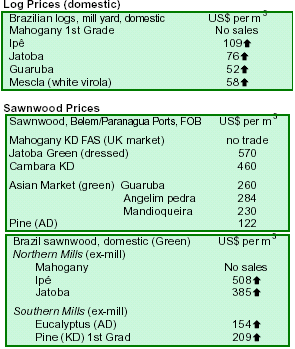
8. PERU
Political uncertainty puts new investment on hold
The Peruvian currency, the Nuevo Sol (NS), has devalued over the last weeks due to the proximity of presidential elections and the payment of annual tax liabilities. The uncertainty about who will be Peru¡¯s next president has affected new investments and industrial activities in the country. Wood firms are refraining from
attending relevant international events and purchasing machinery despite growing international demand for Peruvian manufactured products.
INRENA steps up fight against illegal logging
INRENA continued its fight against illegal logging in the Amazon. The most recent case occurred last week in Pucallpa, northen Peru, when the Navy and the Police
confiscated 34,991 board feet (bf) of mahogany, worth 209,946 NS ($62,670) at the local market. The first batch
of 14,123 bf was found in a hidden warehouse while the second batch amounting 20,868 bf was confiscated in
ships sailing the Ucayali river.
In southeast Peru, following an operation lasting more than one week, officers from the
Forest-Technical and Wildlife Administration Office of Tahuamanu and Police of Iberia, Department of Madre de Dios, confiscated more than 26,800 bf of mahogany sawnwood valued at 160,926 NS ($48,038) in the local market. The wood was found hidden near the boarder with Bolivia in 899 different places. Apparently, illegal loggers intended to smuggle the product to Bolivia.
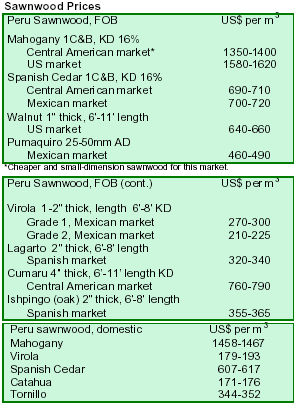
9. BOLIVIA
Santa Cruz consolidates lead in forestry
Santa Cruz is the most important state for forestry in Bolivia. It accounts for 16 million ha (30%) of the 53 million ha of tropical forest land in the country. About half of the 9 million ha of the country¡¯s forest area under
sustainable forest management located in Santa Cruz.
Santa Cruz also accounts for 60% of the country¡¯s 2.2 million ha of certified forests. The state¡¯s exports of wood and wood products totalled $38.4 million in 2005, 43% of the country¡¯s total. Exports reached $6.6 million in January-February 2006, up 27% over the same period in 2005 and the fourth consecutive annual increase achieved.
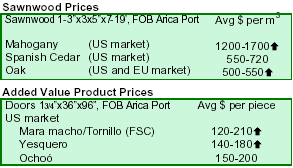
10. Guatemala
Incentive programme beefs up teak plantations
Guatemala has 6,823 hectares of plantation teak, up 2% from 2004. This accounts for 16% of the total teak plantation area in Central America. Plantation forests have been expanding in Guatemala due to the Programa de Incentivos Forestales (PINFOR), an incentive programme through which the state offers money to land
owners during the first six years of reforestation activities.

11.
Guyana
Guyana maintains main markets for exports
At the end of February 2006, exports of forest products from Guyana amounted to over $6 million. Logs and sawnwood accounted for the bulk of the exports. The Caribbean is still the main destination for dressed lumber, accounting for more than half of lumber exports. Barbados and purpleheart remains the main destination and export species, respectively. There were notable
increases in prices for most destinations.
The UK and USA continue to be the major export
markets for undressed lumber, notably greenheart and mora. Of notable significance is the emergence of burada (Parinari spp., previously deemed non-commercial) as a new export species. Prices were generally steady with some markets, notably the UK, showing appreciable gains. Red cedar commanded the highest price in February.
Barama gets world¡¯s largest FSC certified FMU
As previously announced (TTM 11/4), Guyana was recently awarded its first certified forest management unit (FMU). Barama Company Limited, Guyana¡¯s largest forest company, formally received from SGS/QUALIFOR a FSC certificate for forest management. The FMU of 570,000 hectares of natural forests located in Barama¡¯s concession in Northwest Guyana is now the world¡¯s largest tropical natural FMU to be certified by FSC. The company has been in operation for over 15 years, producing mainly plywood for exports to the USA and Caribbean. The certificate is valid for 5 years effective February 2006. This is the
first FSC certificate to be issued in Guyana, Suriname and French Guyana.
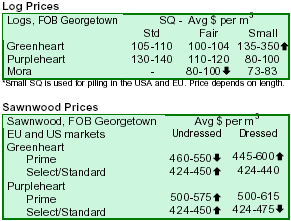
|